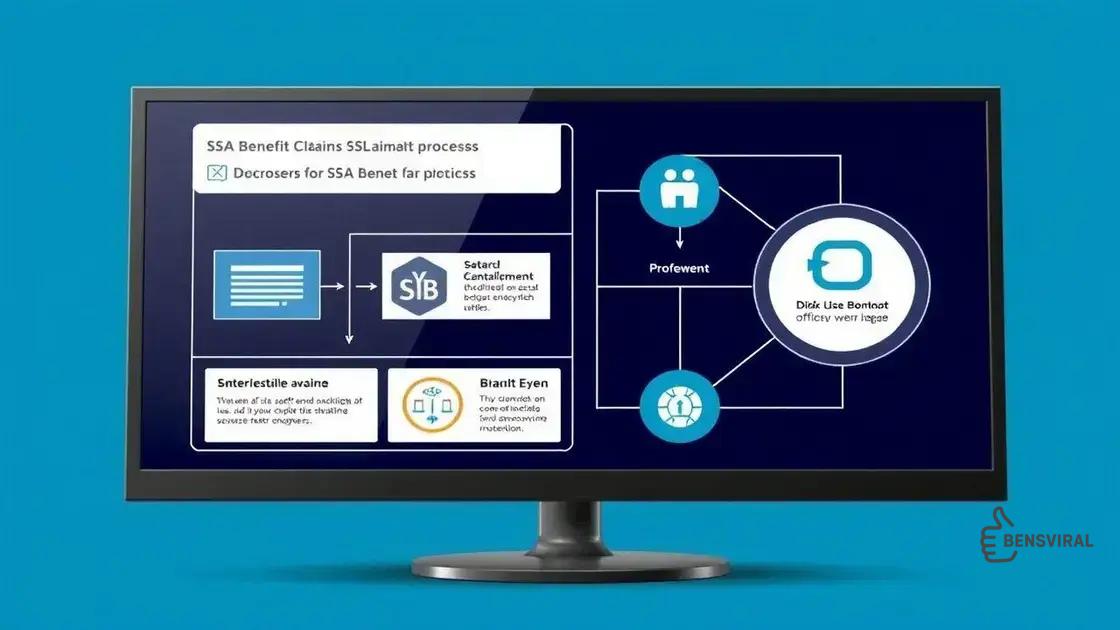Use of automation in processing SSA benefit claims

The use of automation in processing SSA benefit claims significantly improves efficiency, reduces wait times, and enhances accuracy, leveraging technologies like AI and machine learning to streamline operations.
Use of automation in processing SSA benefit claims is changing how applications are managed. Imagine speeding up the claims process while ensuring accuracy and reliability. In this article, we dive into the impact of automation on SSA claims.
Understanding SSA benefit claims
Understanding SSA benefit claims is essential for anyone navigating the system. The Social Security Administration (SSA) provides various benefits, including retirement and disability payments. To grasp the process, it’s crucial to know how these claims work.
The initial step is to gather all necessary documentation. This includes your work history, medical records, and identification. Proper documentation can significantly affect the outcome of your claim. In this section, we will explore the different types of SSA benefits and what is required for each.
Types of SSA Benefits
There are primarily two types of benefits provided by the SSA: Social Security Disability Insurance (SSDI) and Supplemental Security Income (SSI). Understanding these can help applicants determine which route to take.
- SSDI: For individuals who have worked and paid Social Security taxes.
- SSI: For individuals with limited income and resources.
- Retirement Benefits: Offered to those who have reached retirement age.
Next, it’s crucial to know the eligibility criteria for these benefits. The SSA has specific rules around work history, medical conditions, and financial status. Meeting these requirements is vital for a successful claim.
Filing Your Claim
Once you have your documentation, the next step is to file your claim. You can do this online, over the phone, or in person at your local SSA office. Online applications tend to be quicker and easier for many individuals.
After you file your application, it enters the review process. The SSA will examine the information you provided, which can take several months. During this time, they may request additional documentation or clarification. Patience is key during this stage.
Understanding the different stages of your claim helps set realistic expectations. Whether it’s waiting for approval or addressing potential denials, knowing the process aids in better preparation.
In summary, grasping the fundamentals of SSA benefit claims ensures applicants can navigate the system more effectively. Awareness of the requirements, documentation, and filing processes lays a smooth path for claimants seeking assistance.
Benefits of automation in SSA claims
The benefits of automation in SSA claims processing are substantial. With technology improving rapidly, the SSA can make the claims process faster and more efficient. Automation reduces the time applicants wait for decisions, leading to quicker access to benefits.
By automating tasks, the SSA can also minimize human errors. This accuracy is crucial, as mistakes can delay claims or even lead to denial. When automated systems handle repetitive data entry, human staff can focus on more complex tasks, improving overall productivity.
Increased Efficiency
Automation streamlines the entire claims process. For instance, automated systems can gather and analyze data more swiftly than manual input. Additionally, it helps in tracking the status of claims easily.
- Faster processing times: Benefits can be delivered more quickly to applicants.
- Reduced paperwork: Automation cuts down on the amount of documentation needed.
- Data management: Automating data processing allows for better organization and retrieval.
Moreover, automation brings about cost savings. By cutting down on the need for extensive staff to manage paperwork and inquiries, the SSA can allocate funds toward other important services.
Enhanced Customer Experience
An automated system also improves the experience for applicants. With user-friendly online platforms, individuals can submit and track claims with ease, providing transparency throughout the process. This convenience is essential for many applicants who may already be dealing with challenges in their lives.
Furthermore, automated responses can allow for immediate feedback on status updates. This immediate information is vital as applicants want to know they are moving forward with their claims. Knowing where they stand can reduce stress during the waiting period.
In summary, the benefits of automation in SSA claims are clear. With increased efficiency, accuracy, and enhanced customer experience, automation not only helps the SSA serve applicants better but also promotes a faster resolution of claims.
Key technologies in automation

Key technologies in automation are transforming how the SSA manages claims. By leveraging modern tools, the SSA enhances efficiency and accuracy in processing applications. Understanding these technologies can provide insights into how automation improves service delivery.
One primary technology is artificial intelligence (AI). AI streamlines data analysis, allowing quicker decision-making. It can identify patterns in claims data, helping staff focus on high-priority cases.
Machine Learning
Machine learning algorithms also play a significant role in automation. These systems learn from past data, improving their accuracy over time. As these models adapt, they help predict outcomes for future claims, ensuring a smoother process for applicants.
- Predictive analytics: Helps assess claims accuracy and eligibility.
- Fraud detection: Monitors patterns that may indicate fraudulent activity.
- Claim prioritization: Streamlines workflows by identifying urgent cases quickly.
Another key technology is cloud computing. Using cloud services, the SSA can store and access vast amounts of data securely. This flexibility enables easy updates and real-time collaboration among staff, enhancing overall service efficiency. With cloud-based systems, employees can retrieve information from anywhere, accelerating the claims process.
Robotic Process Automation (RPA)
Robotic Process Automation is another critical innovation. RPA software automates repetitive tasks, reducing the need for manual data entry. This not only saves time but also minimizes errors in processing. With RPA handling routine activities, staff can dedicate more attention to critical, customer-facing tasks.
Additionally, technology such as blockchain is starting to emerge in the SSA’s processes. Blockchain enhances security, ensuring that data integrity is maintained. As more organizations adopt blockchain, its potential to support secure transactions in the claims process could revolutionize how information is shared.
In summary, embracing these key technologies in automation allows the SSA to provide better, faster services to beneficiaries, ensuring that claims are processed with higher accuracy and efficiency.
Challenges of implementing automation
While the benefits of automation in SSA claims processing are clear, there are also challenges involved in implementing these technologies. Understanding these obstacles is essential for ensuring successful integration and operation.
One significant challenge is the cost of implementation. Initial expenses for software, training, and necessary infrastructure can be substantial. Many organizations may hesitate to invest such resources without guaranteed returns, creating hesitation in adopting these changes.
Resistance to Change
Another barrier is the resistance to change from staff. Employees may fear that automation will replace their jobs, leading to anxiety and pushback against new systems. Effective communication about the advantages of automation, including how it can assist rather than eliminate jobs, is crucial for addressing these concerns.
- Training needs: Staff require adequate training to adapt to new systems.
- Employee morale: It’s important to maintain morale during transitions to automated processes.
- Job security: Clear communication about job roles can alleviate fears.
Furthermore, data privacy and security are top concerns. As the SSA handles sensitive personal information, ensuring that automated systems are secure is vital. Any data breaches could lead to significant repercussions, both for the agency and individuals.
Technical Challenges
Technical issues also pose challenges. Integrating new automation technologies with existing systems can be complex. It often requires customizing solutions, which can lead to increased timeframes and costs. Despite the potential benefits, technical problems can slow down the rollout process.
Moreover, ongoing maintenance and support needs are key considerations. Automation systems require regular updates and monitoring to function effectively. The lack of a robust support system can hinder the overall performance and reliability of these technologies.
In summary, while automation promises to improve efficiency in SSA claims processing, the challenges associated with implementation must be carefully managed. Addressing cost issues, resistance to change, data security, technical hurdles, and maintenance needs are critical steps for successful integration.
Future trends in SSA claims processing
The future trends in SSA claims processing are shaped by rapid advancements in technology. As automation continues to evolve, the SSA is likely to incorporate innovative practices that improve efficiency and service delivery. Understanding these trends helps anticipate how claims processing will change.
One major trend is the increased use of artificial intelligence (AI) to assess and process claims. AI can analyze large sets of data quickly, identifying patterns and trends that help speed up decision-making. By utilizing AI, the SSA can enhance its accuracy and reduce the time needed for evaluations.
Personalized Service
Alongside AI, the move toward more personalized services is emerging. With data analytics, the SSA can tailor its communications and processes to individual needs. This personalized approach can improve overall satisfaction among beneficiaries, making the experience more user-friendly and responsive.
- Targeted outreach: Providing information specific to individual circumstances.
- Custom notifications: Alerting beneficiaries about their claim status in real time.
- Enhanced support: Offering personalized assistance based on unique needs.
Another trend is the greater emphasis on data security. As technology improves, so do the complexities of cybersecurity threats. The SSA will likely invest in advanced security measures to protect sensitive information, ensuring that beneficiaries’ data remains confidential.
Integration of Blockchain
The integration of blockchain technology is also on the horizon. Blockchain offers a secure way to manage claims data and transactions. This transparency can help reduce fraud and enhance trust in the system, while ensuring that all parties have access to accurate information.
Moreover, there is an increase in mobile access as more beneficiaries prefer using their smartphones for communication. The SSA may develop mobile-friendly applications that allow users to submit claims, track statuses, and receive updates directly from their devices. This accessibility can enhance user experience and streamline processes.
In addition to these advancements, predictive analytics will likely become more prevalent in claims processing. By analyzing historical data, the SSA can better forecast future claims trends, allowing for effective resource allocation and staff planning.
In summary, the future of SSA claims processing is poised for transformation. With innovations in AI, personalized services, data security, blockchain integration, and mobile access, the SSA can significantly enhance how it serves beneficiaries.
FAQ – Frequently Asked Questions about Automation in SSA Claims Processing
How does automation improve SSA claims processing?
Automation helps reduce wait times and enhances accuracy in processing claims, allowing for quicker decisions.
What technologies are being used in SSA claims automation?
Key technologies include artificial intelligence (AI), machine learning, blockchain, and robotic process automation (RPA).
What are some challenges of implementing automation at SSA?
Challenges include costs of implementation, resistance to change from staff, and the need for robust data security measures.
What future trends can we expect in SSA claims processing?
Future trends include increased personalization of services, enhanced mobile access, and more reliance on data analytics.






